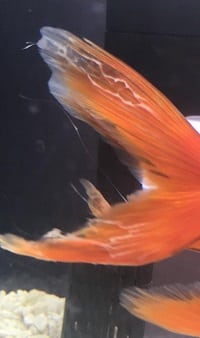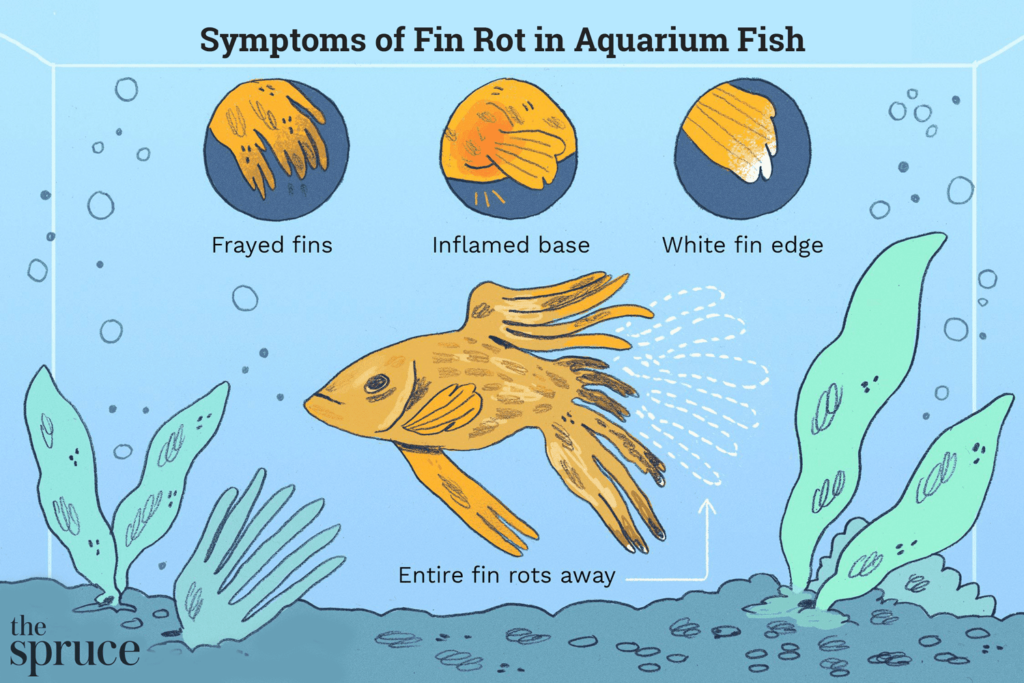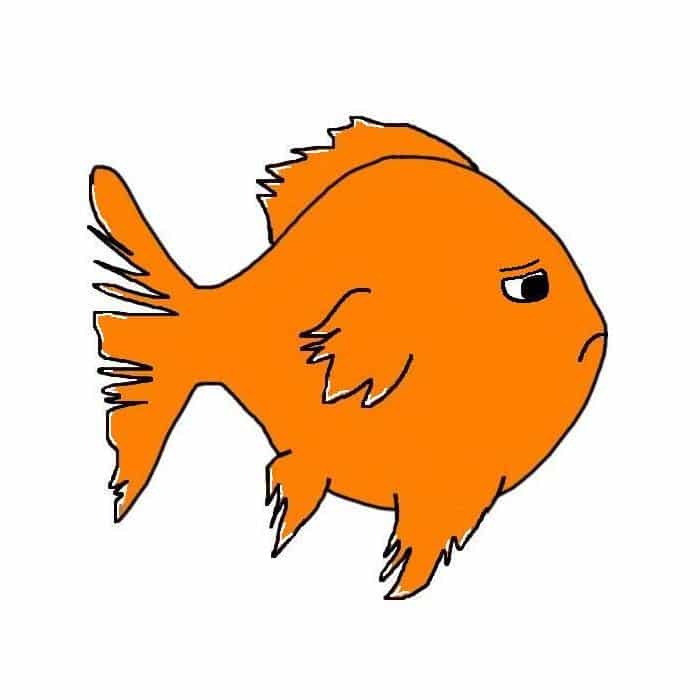Fin rot isn’t a disease in itself, but rather a symptom of disease or infection.
If your goldfish has fin rot then you will notice their fins start to appear frayed or ragged, as if they’ve been torn.
You may also notice a white or red edge where the fin appears broken. Act immediately before the symptoms get worse!
In this post, we’re going to look at what fin rot is, what causes it, and – most importantly – how to treat it so that your goldfish doesn’t have to suffer or even die.
What is fin rot?

Fin rot isn’t a disease. It’s a symptom of a disease or some other problem with your fish.
If your goldfish has fin rot, its fins will start to look torn and ragged, as if they’re rotting away. You might notice a red or white outline on the edge of the fin.
A fish with fin rot is likely to rub up against the side of the tank and against decorations.
Causes of Fin Rot in Goldfish:

It can be difficult to identify exactly why your fish has fin rot, as there are several possible causes. These include fighting with other fish, stress caused by injury or disease, bacteria and parasites, and poor water quality.
Poor water quality is the number one cause of fin rot.
All fish tanks contain a lot of bacteria, which isn’t usually harmful to your fish. However, when your water quality is poor, your tank can contain more “bad” bacteria, and your fish can become stressed. This lowers their immune system.
A combination of a low immune system and lots of bacteria can lead to bacterial infection. This means that bacteria eat away at your fish’s fins!
Bacterial infection is particularly likely to happen if your tank is overcrowded, your water quality is poor or your fish gets injured.
For example, if another fish nips at its fins or if it scratches itself on a sharp decoration or piece of gravel.
Unfortunately, once fin rot occurs, the injured fish and other fish in the tank can quickly make the problem get worse and worse. Affected fish often “scratch” themselves against the side of the tank or against decorations. It’s like a child with chickenpox who shouldn’t scratch, but really wants to because they’re itchy!
This can cause more damage to the fins, which allows more bacteria to infect their wounds and makes the problem worse.
Other fish often bully fish that are ill or injured. Again, this can cause more wounds, which then allows more infection to take hold.
Risk Factors
Environmental Factors Contributing to Fin Rot
Maintaining a clean and well-regulated environment is paramount in preventing fin rot. Factors such as ammonia buildup, fluctuating water temperature, and inadequate filtration can create an environment conducive to bacterial infections.
Common Mistakes in Goldfish Care
Goldfish care is an art, and avoiding common mistakes is essential. Overfeeding, neglecting water quality, and inadequate tank size are frequent errors that can contribute to the onset of fin rot.
How to treat fin rot

The earlier you spot the problem, the easier it is to treat it with the right remedies.
You should therefore constantly keep an eye on your fish and look out for any sign of damaged fins.
When you spot signs of fin rot, you should quickly follow these steps:
- Make sure that your tank is big enough for your fish. You should have done this anyway of course, but it’s worth double-checking that your tank definitely isn’t overcrowded. It’s very difficult (or in some cases impossible) to maintain good water quality in a tank that contains too many fish.
- Make sure that your water quality is good. Use a test kit that measures ammonia, pH, nitrite, and nitrate to check that your tank has a pH of around 7-8, zero ammonia, zero nitrites, and nitrates no higher than 40 ppm.
- Clean your tank. Hoover the gravel, clean your filter sponges (in water from your tank, not from the tap), and do a 30% water change.
- Use a special treatment. Buy an anti-bacterial fin rot treatment and follow the instructions on the bottle.
- Monitor your fish’s recovery and keep a clean tank. Are their fins starting to look better? Have they stopped rubbing up against things? Do other fish definitely not bully them? Keep your tank clean, keep testing your water, and keep doing regular water changes.
Conclusion
In conclusion, fin rot is a treatable condition, and with the right knowledge and proactive care, goldfish can thrive. By understanding the causes, recognizing early signs, and implementing effective prevention and treatment strategies, goldfish owners can ensure the well-being of their aquatic companions.
FAQs
- Q: Can fin rot be completely cured at home?
- A: While mild cases can be treated at home, severe fin rot may require professional veterinary intervention for a comprehensive cure.
- Q: How often should I change the water in my goldfish tank?
- A: Regular water changes, typically 20-30% every 1-2 weeks, are essential to maintain optimal water conditions.
- Q: Are there preventive measures to avoid fin rot altogether?
- A: Yes, maintaining a clean tank, providing proper nutrition, and minimizing stress are key preventive measures.
- Q: Can I use multiple treatment methods simultaneously?
- A: It’s advisable to consult with a veterinarian before combining different treatment methods to avoid potential complications.
- Q: Are there specific breeds more prone to fin rot?
- A: All goldfish breeds are susceptible to fin rot; however, proper care significantly reduces the risk for any breed.

What if it appears that your fintail gold fish has fin rot but also is laying on its side On the bottom of the tank not swimming or anything too, moved from the tank that had a plecko that was attacking it, what all could be happening?
Hi Jason, thanks for your comment,
Goldfish laying on the bottom is a key sign of stress and discomfort, this will be caused by the fin rot, it can also be caused by the treatment used to cure fin rot, especially chemical treatments witch are high in copper.
The pleco attacking the goldfish is quite a common occurrence, what is happening is the pleco is trying to eat the slime coating off the goldfishes skin, this can cause harm to the goldfish, especially while it is under stress, I would recommend separating your pleco in a floating tub or breeder box.
hope this helps.
I have 3 comet goldfish. One of them started losing its gold color, so now its almost completely white except for some gold on its head. This does not appear like a disease, but more his color just fading away. The other 2 fish are still their normal color. Is this color change normal?
Hi there, goldfish changing colour is a common occurrence, we actually have an article written on it here where you can find out more: why do goldfish change color?
I have a gold fish that got trapped in a log. It happened whithin the 2-3 hours I was gone. In her stress and flailing around she lost quite a few scales(alot) and tore her fins.
I got up this morning to check on her and her tail looks like its been chewed upon.
Im going to get some fin rot just in case. Is there anything else you can suggest?
Shes 3 years old and about 5-6″ long. Beautiful white/pink pearly girl. Help! I just love her soo much!
Hi Rebecca,
we would suggest against using finrot treatment until you see definite signs the disease is present, you are thinking right by getting some treatment just in case, but we would recommend not using meds unless absolutely necessary, its like if you cut your arm and immediately take antibiotics, it often does more harm than good as it weakens the immune system.
If you do see fungus on the fins absolutely use it, but we dont suggest using any meds as a preventative measure.
In this scenario it is better to use melafix, it aids in healing and isnt a chemical antibiotic, but a herbal substance.
If the water is clean and there are no pathogens, the goldfish will be fine in most cases and will heal on its own.
What we would suggest turning up the temperature, increasing aeration, doing more water changes, using melafix and feeding more to assist in healing.
we would also suggest removing that log.
I personally have had a similar issue with my pond fish, where 3 of my adult goldfish got themselves stuck behind a pot, they had been stuck there for around 4 days without me realising as i thought they had been eaten by heron. When I found them and released them, their sides were worn away and they started to grow fungus on them. I treated them using nothing but melafix, it took around a month of dosing it day in day out but they healed fully.
The fish are still alive today and are extremely healthy.
Melafix is an excellent substance when it comes to treating injured fish, as it does the job without the drawbacks of using strong antibiotics.
We hope this information helps and hope that your goldfish pulls through, good luck 🙂
I have gold fish tail rod and not active what antibiotics do I have to apply?
I have a fish that has an injured fin. He also recently had a wen trimming hoping it would fix his issue of being upside down. He could swim normally but would rest upside down. Since getting his tail fin caught in the filter he has part of it missing. What can I do I’ve tried everything peas for swim bladder mela fix wen trimming (done by a vet) now salt and antibiotics. I’m so upset to see him like this and I feel he is moving less and less now. He is bent when floating I fear it could be a tumor.
My 20 years old goldfish